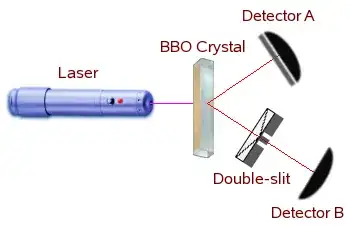First off - I am not an expert. I am intrigued by quantum physics and have a layman's understanding at best. I've looked at other questions, but either the answers are not answering my question, or I've failed to understand the answer (entirely possible). If the latter, then if I could trouble you for a simple explanation, I would appreciate it.
I was reading this article. In the "Quantum Eraser" section at the bottom, there is the following text:
Figure 6.5 shows a Bell-state quantum eraser, named after John Bell. It illustrates the application of the following steps:
- a laser fires photons into a Beta Barium Borate (BBO) crystal;
- the crystal entangles some of the photons; and then
- entangled photons travel to two different detectors: A and B.
Placed between the crystal and detector B is a double-slit, like in the previous experiments. Immediately in front of detector A is a polarizing filter that can be rotated. Figure 4.5 showed an experiment using sunglasses to see the effects of rotating a polarizer. Those same effects apply here.
The Bell-state quantum eraser has one more feature: each slit is covered by a substance that filters the polarization of a photon. Consequently, the left-hand slit will receive photons with a counter-clockwise polarization, and the right-hand slit will pass photons with a clockwise polarization.
Note: Polarization does not affect interference patterns.
Initially, neither detector shows an interference pattern. Since we control the polarization of photons passing through the slits and we know the polarization accepted by each slit, we can deduce which way the photons travelled (counter-clockwise through the left; clockwise through the right). Thus no interference patterns are detected.
However, if we rotate the polarizing filter in front of detector A so that the polarizations of the photons that hit the detector are the same (that is, we can no longer distinguish between clockwise and counter-clockwise polarizations), then the interference pattern appears at both detectors!
How do the photons arriving at detector B know that the polarizations have been "erased" at detector A?
I find this result fascinating, and disturbing. By rotating the filter at A, I can change the interference pattern at B. In fact, if I was in charge of the filter at A and a friend was watching detector B, they could tell when I rotated the filter right? If so, then isn't this communication?
If A and B are spatially separated by many light years, wouldn't this even be FTL communication?
Is there something wrong with the article I linked? Perhaps I am misunderstanding it, but it seems pretty clear to me.
